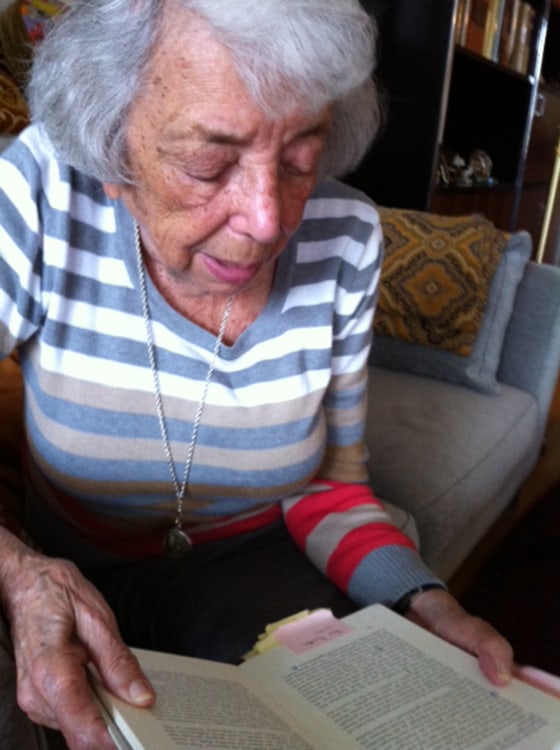Margot Friedlander hid for 13 months before being discovered in April 1944 and sent to Theresienstadt Concentration Camp in what is now the Czech Republic.
It was in Theresienstadt that Friedlander met and married her husband. They immigrated to New York in 1947 and vowed never to return to Germany. Most members of both their families were murdered at Auschwitz, the German death camp in Poland.
The catalyst for Friedlander’s return was a memoir class she took after her husband’s death in 1997. The class was at the 92nd Street Y, a New York cultural center, where her husband had been the comptroller.
I wrote every night,” she recalled during an interview in her apartment in a high-end Berlin senior residence. Geraniums adorned the apartment’s balcony; below was a kindergarten.
I had all these stories in my head. Everything started coming back to me, many things that I pushed aside for years.
Now, Friedlander tells her story to German teenagers, always inspired by the last message her mother gave her: “Versuche, dein Leben zu machen,” or “Try to make a life.” This became the title of her 2008 memoir, published in German.
“Young Germans tell me what they get from me is different from a teacher or a book,” she said, “because my story is from my heart. It’s my story. I speak for the people who can’t speak anymore.”
German documentary producer Thomas Halaczinsky, who lives in New York, heard Friedlander read from her memoir at the 92nd Street Y.
“It was very interesting and important,” he said in a phone interview. Halaczinsky wanted to do a documentary about Friedlander’s life, which required her to return to Germany with him.
She agreed to go to Berlin, despite the decision she’d shared with her husband that they would never return.
Halaczinsky recalled their first night in Berlin. “We did a lot of walking throughout the city,” he said. “She knew every shop that was ever there and every street corner. It was as if she never left.”
According to Halaczinsky, the experience of filming the documentary in Berlin made Friedlander think about returning permanently, to live once again in her native city.
Halaczinsky’s documentary -- “Don’t Call It Nostalgia” -- premiered at the Woodstock Film Festival in October 2004. Halaczinsky and Friedlander remain close friends. “My continuing friendship with her is a continuation of her life story,” he said.
When Friedlander made the final decision to live in Berlin, she encountered fierce opposition from her German-Jewish friends in New York. No one could understand how she could return to a place whose inhabitants had murdered so many Jews and all their loved ones.
But Friedlander, who wears her mother’s amber necklace, was also motivated to return because 16 Germans helped her hide for 18 months, while risking their own lives.
“I had Germans who helped me,” she said. “They did not know me. I was cared for by good people, even though they were few.”
After emerging from a bomb shelter in April 1944, she was apprehended and questioned by the Gestapo. She admitted she was Jewish.
While in hiding, Friedlander had to move frequently to avoid detection. She was told never to ask the names of those who hid her, nor where they lived. Her protectors feared that if the Nazis caught her she would expose the underground network.
Friedlander was only able to find one of her saviors, Gretchen Camplair, who was gravely ill by the time she met her. She said she thanked the dying woman and stroked her hands.
Friedlander continues to battle the demons that haunt many Holocaust survivors. Why did she survive when her loved ones perished? To justify her survival, she clings to her mother’s message that she should make a life.
“I did what my mother wanted me to do,” she said. And yet, when asked if she still struggles with guilt, she replied, “In a way, yes.”
“I am often asked how I can go back to the country that murdered my parents,” she said softly.
“I don’t regret it for a minute. I am reaching out to young Germans and they care about what happened here.”
When she dies, Friedlander said she expects to return to America, to be buried beside her husband.
Related:
